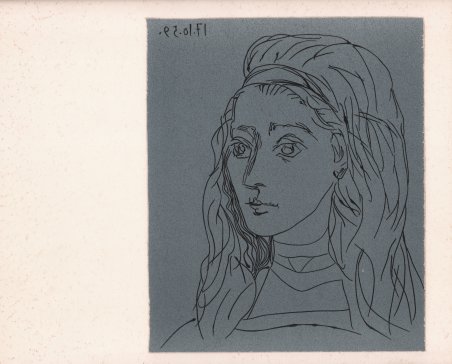Questa linoleografia presenta un ritratto della seconda moglie di Picasso, Jacqueline Roque. Roque fu una delle famigerate muse di Picasso e ispirò Picasso con la sua bellezza. Picasso creò centinaia di ritratti di lei in tutti i medium in cui lavorò, dalla pittura alla ceramica alle linoleografie. Questa linoleografia mette in evidenza il collo lungo ed elegante di Roque, il suo naso dritto e i capelli lunghi e fluenti. Il disegno mostra lo stile geometrico riduttivo di Picasso, che utilizza linee e colori semplici per creare una bella composizione. Jacqueline lavora presso Madoura, la ceramista con cui Picasso collabora dal 1946. Sposatisi nel 1961 a Vallauris, Jacqueline sarà presente fino alla morte di Picasso nel 1973. Originariamente rilegata nella prima edizione del ' Picasso Linogravures, ' (con la firma e il numero a matita di Pablo Picasso), questa straordinaria linoleografia fu pubblicata in un'edizione limitata di 50 copie (Casa editrice Gerd Hatje, Stoccarda 1962). Nella introduzione del libro ' Picasso Linogravures, ' pubblicato Gerd Hatje, ' Stuttgart ' and ' Éditions Cercle d’Art, Paris in 1962, ' Wilhem Boeck spiega il perchè Picasso ha iniziato a realizzare libri con questo tipo di tecnica di stampa: “Picasso ' had recently become an adept of cut-linoleum printing. It was a new activity, and doubtless owed to the artist’s desire to give colour pride of place within printed creations when graphic arts had, until then, consigned it to a subordinate role – even in lithography. Taking up the gouge was less, for Picasso, about exploring a new realm of objects and forms, then exposing the forms he had mastered to the rigours of as-yet untested technical possibilities. As he did every time he embarked on a new task, be it sculpture, lithography, ceramics or aquatints, the result obtained can be compared to nothing but previous creations by Picasso himself”. Picasso ha inventato il metodo della riduzione, tagliando progressivamente lo stesso blocco di linoleum per ogni nuovo colore. Nel 1962, in collaborazione con Picasso e la Galerie Louise Leiris, sono state realizzate nuove lastre di linoleum al 42% della dimensione originale, ed è da queste che sono state realizzate le stampe [Dimensioni: 12,6 x 14,2 in (32 x 36 cm)], per l’edizione Circle d'Art, Parigi 1962. Queste linoleografie sono rinomate per la loro alta qualità e fedeltà a Picasso. Una bella impressione con colori freschi e margini pieni. ' Bibliografia Bloch, G. (1984). ' Pablo Picasso, Tome I Catalogue de l’œuvre grave et lithographié 1904 – 1967, n. 923. This linocut features a portrait of Picasso’s second wife, Jacqueline Roque. Roque was one of Picasso’s infamous muses, and inspired Picasso with her beauty. He created hundreds of portraits of her in every medium he worked in, from painting to ceramics to linocuts. This linocut showcases Roque’s long, elegant neck, her straight nose, and long, flowing hair. The design shows off Picasso’s geometric reductive style, using simple lines and colors to create a beautiful composition. Jacqueline works at Madoura, the ceramist with whom Picasso had collaborated since 1946. They married in 1961 in Vallauris, Jacqueline will be present until Picasso's death in 1973. Originally bound into the first edition of picasso linogravures (with the signature and number in pencil by Pablo Picasso), this extraordinary linocut was published in a limited edition of 50. In the introduction of the book, published by ' Verlag Gerd Hatje, ' Stuttgart ' and ' Éditions Cercle d’Art, Paris in 1962, ' Wilhem Boeck ' tells us why the great artist started to make a book with this printing technique: “Picasso ' had recently become an adept of cut-linoleum printing. It was a new activity, and doubtless owed to the artist’s desire to give colour pride of place within printed creations when graphic arts had, until then, consigned it to a subordinate role – even in lithography. Taking up the gouge was less, for Picasso, about exploring a new realm of objects and forms, then exposing the forms he had mastered to the rigours of as-yet untested technical possibilities. As he did every time he embarked on a new task, be it sculpture, lithography, ceramics or aquatints, the result obtained can be compared to nothing but previous creations by Picasso himself”. Picasso invented the ereduction method, progressively cutting the same linoblock for each new colour, ' making it impossible to take any further prints from the original plates. In 1962, in collaboration with Picasso and Galerie Louise Leiris, new linoleum plates were made at 42% of the original size, and it was from these that the prints were made [Size: 12.6 x 14.2 in (32 x 36 cm)]. For France edition Circle d'Art, Paris 1962. These linocuts are renowned for their high quality and fidelity to Picasso's. A fine impression with fresh colors and full margins. Bibliografia Bloch, G. (1984). ' Pablo Picasso, Tome I Catalogue de l’œuvre grave et lithographié 1904 – 1967, n. 923. Cfr.

Scopri come utilizzare
Scopri come utilizzare

